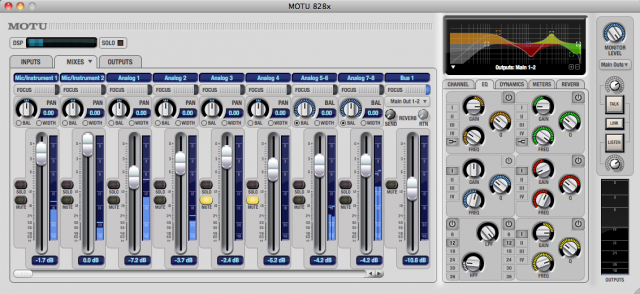The MOTU 828 series has been a workhorse if ever there was one. Since the very first model, its more-then-ample I/O, mixing, clocking, and design have made it a favorite in a market crowded with lots of fairly-similar audio interfaces. It’s just more versatile and has easier access to controls and metering than some of its rivals.
That means the arrival of an 828 with Thunderbolt matters. The 828x still has USB 2.0, so you aren’t limited to Thunderbolt connections, and it supports both OS X and Windows. But when connected to Thunderbolt, you get some distinct advantages. The bus itself (even with Thunderbolt 1) is fast enough to support more bandwidth than any audio user would likely ever need, meaning that an 828x can sit at the end of a chain of six devices. That’s true even if you’re connecting bandwidth-thirsty drives or high-res displays. (And, vital since a lot of MOTU customers come from the pro video world, that has particular implications for video.)
Even if you’re just using an 828x over Thunderbolt, though, there should be distinct advantages in reliable low-latency performance. Remember that getting low latency isn’t just about speed, but about the ability to maintain that speed in high-bandwidth applications. There, Thunderbolt’s implementation has been so far remarkably stable, meaning some good things for audio performance.
MOTU tells us:
Latency is comparable to the 828mk3 Hybrid connected via FireWire. Bandwidth, though, is MASSIVE (many times FW). At NAMM we have MacBook Pros and HP laptops equipped with TB, connected to TB displays, TB drives and the 828x (at the end of the chain). You can daisy-chain up to 6 TB devices off one port (each TB port on the host gets its own bandwidth, they don’t share like FW), so these are slammin’ systems.
Count us in.
There are a lot of decade-plus-old 828s out there, so seeing all this in the 828 chassis says some nice things. And I could believe Thunderbolt will last us another 10 years. (A FireWire investment back then was a smart one.)
Beyond that, this is feature-packed just like the 828 you know:
- 28 ins, 30 outs
- Up to 192 kHz recording
- “Studio-grade” mic channels with a pre-converter send for outboard gear and hardware limiting
- On-board digital mixer with effects (that does often come in handy)
- — and it works as a standalone mixer (ditto)
- OS X, 7/8/Vista support, WDM, ASIO, Core Audio
- MIDI I/O
- Two optical banks
- All the extras: instrument tuner, SMPTE clock, expansion, signal analysis tools
- CueMix, AudioDesk for added mixing and processing versatility
Product:
http://www.motu.com/products/motuaudio/828x
Tech specs:
http://www.motu.com/products/motuaudio/828x/specs.html
Available now; pricing US$999 list (but about $850 street)
(And MOTU still makes the 828mk3 for FireWire users.)
And, wow, an audio interface gets a video!



